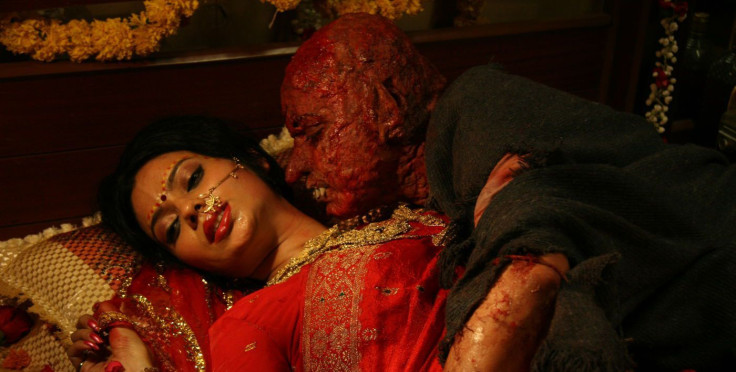Just like mutated frogs warn us of pollution, horror movie anthologies are excellent proxies for the state of the horror movie ecosystem. In the early 70’s Amicus anthologies like Asylum and The House That Dripped Blood wrung the last bit of blood from the prolific Robert Bloch and managed the decline of Hammer’s 60s grandeur, by that point decaying into cheap sequels and increasingly demeaning roles for Christopher Lee.
Creepshow defined the 80s with its comic, splatter instincts (“meteor shit!”) and garish colors, transforming Stephen King into the mass media figure capable of delivering Maximum Overdrive just a few years later. And then came two decades of comparative obscurity, the anthology horror film being a poor fit for both the 90s slasher revival and the 00s hunger for Saw-like series possibilities. When Trick ‘r Treat spent two years on the shelf it seemed like maybe the horror anthology was gone for good, a relic that no longer fit with the blockbuster model and the business’ demand for new IPs to franchise.
But the horror movie anthology came roaring back with 2012’s V/H/S and The ABCs of Death. This new era embraced both the 80s nostalgic mode (V/H/S) and the freneticism of meme culture, fracturing a feature length runtime over dozens of snack-sized stories (The ABCs of Death). Indie horror pioneered digital delivery, embracing cult niches reachable through online quasi-communities and spawning talent incubator anthology projects like Southbound and the all-female directors showcase, XX. But will this new wave of horror movie anthologies subside into diminishing sequels and slow obsolescence?
We spoke with one of the architects of the new anthology wave, Ant Timpson, producer of The ABCs of Death series (and The Greasy Strangler!), about his new movie The Field Guide to Evil, which might just revolutionize anthology horror for the decade to come.
Very little has been revealed about the actual plot of The Field Guide to Evil, though Timpson made one thing clear: “I can say adamantly there won’t be a cryptkeeper.” But what’s interesting and potentially groundbreaking about The Field Guide to Evil is the international horror dream team Timpson and co-producer Tim League (founder of Alamo Drafthouse and Drafthouse Films) have assembled and the untested new crowdfunding mechanism backing the picture.
The Field Guide to Evil unites eight horror filmmakers from around the world. Each will tell a dark myth or folktale from a specific country, sharing their monsters, lore and darkest fears. Included in the project are the directing duo behind the 2014 Austrian horror movie Goodnight Mommy, Peter Strickland (Berberian Sound Studio, The Duke of Burgundy), Agnieszka Smoczynska (The Lure), Katrin Gebbe (Nothing Bad Can Happen), Can Evrenol (Baskin - our review), Calvin Reeder (The Rambler), Ashim Ahluwalia (Miss Lovely) and Yannis Veslemes (Norway).
It’s a movie that could only be accomplished with the world’s fattest horror rolodex, making The Field Guide to Evil one of the most interesting horror movies in the works even without knowing a single plot point.
Like every horror anthology, The Field Guide to Evil requires both great individual segments and a well-honed sense for curation. “ABCs was the zenith of that sort of wrangling,” Timpson said. After teaming with over 80 filmmakers producing the ABCs of Death series, The Field Guide to Evil presents the opportunity to tell longer stories and get more involved with each production, constructing an anthology with a more consistent, less scattershot vibe. “The Witch was a great reference point,” Timpson said. They’re looking for “just a freakin’ knock-out folklore,” telling new, unfamiliar stories, delivered without affectation or irony, but “atmospheric, straight and creepy.”
But each segment is just part of the story. Just like with an album, how each short film interacts and their order can define how the audience experiences the movie. “We definitely didn’t want any sort of overlaps or concepts to clash,” Timpson said, while acknowledging it comes down to the filmmakers they’ve assembled. “There’s a bit more faith than on a feature where you’re much more hands-on.” But as the beings seated at the nexus of all creation, Timpson and League will strike the delicate balance between too similar and too dissimilar.
The other element that makes The Field Guide to Evil such an unprecedented project is its use of a new twist on the well-worn Kickstarter model: equity crowdfunding. “It’s such a great new frontier and we really want to be at the front and be the first project out of the gate,” Timpson said. Rather than taking in money as donations or soft pre-orders on an eventual product, funding The Field Guide to Evil is an investment with a potential return. Backers will be buying into the movie and participating in any profits (assuming the movie’s profitable, repayment goes to investors up to a 15% return, with gross proceeds split 50-50 beyond that).
Equity crowdfunding only became legal in the United States in 2015, over objections that it could lead to exploitation of less savvy investors. “There’s risk involved with all film financing on all films,” Timpson said, while also expressing hope that the reputational nature of movie-making would make people feel they could invest confidently in The Field Guide to Evil. “You can have the best wiz-bang new product on the thing, but if it’s from shome shady Porsche-riving guy with a gold chain…” he said. “Tim and I have a lot of stake in personal credibility on the line, so there’s a lot riding on us to deliver to everyone.”
One fascinating side effect of the equity crowdfunding model is the insight it provides into the typically opaque world of film financing. “There’s a lot of smoke and bullshit in the industry and we’ve probably been guilty, but we hope not to be obfuscatory except for a story purpose,” Timpson said. The investment page (still active through the end of March) includes breakdowns on how the budget will be spent, projections for horror movie profitability and even the creative decks used within the industry to pitch projects.
“We want to be kind of transparent through the whole process and if they’ve ever been interested in backing a film for what they can afford — if they’re on the fringe of the industry or wanting to get involved — I think this could be the cheapest sort of film business cost,” Timpson said, “I think in terms of watching it all unfold it will be kind of fun to share the ride with us.”


















